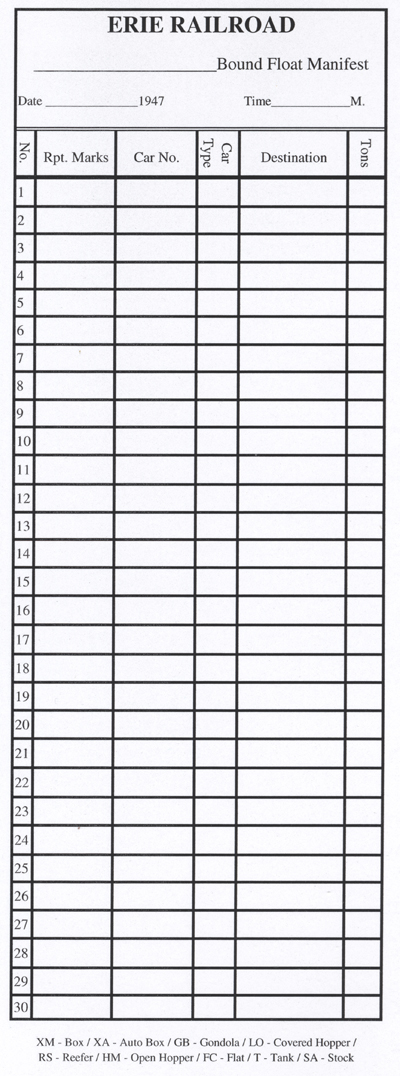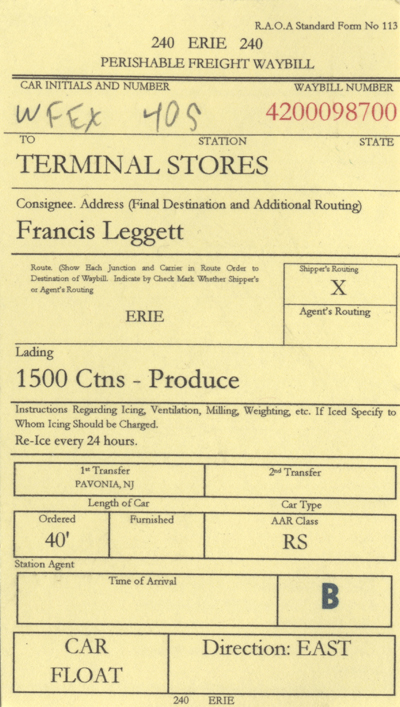|























 
|
|


| Waybill Only and Switch List Operations |
Operations on the New York Harbor Railroad
|
The New York Harbor railroad is comprised of three different railroads and four separate lines. Two of the Lines and Railroads are operated via a switch list system. The other Railroad has two separate lines and is operated via a waybill only system. |
Lehigh Valley: 27th Street Yard
Erie Railroad: 28th Street
New York Central: 30th Street Yard and the High Line. |
Car float Operations on the Lehigh Valley and the Erie
|
Both 27th and 28th Street Operate via a “Switch List” based system. Each yard has a dedicated Agent (Erie: Pavonia, Lehigh Valley: Jersey City). These Agents write three switch lists for every car float that dock at the float bridge. Switch list one is comprised of the entire west bound moves that remove cars from the yard. Switch list two is comprised of the entire east bound moves that bring cars off of the car float and in to the yard. Switch list three is comprised of the entire inter-yard moves that move cars around the yard, these are empties that are move to a platform or spot for reloading. Each Yard has a specific car float roster assign to it and these car floats can bring 14 cars to the Lehigh Valley and 16 cars to the Erie.
Flow of traffic in the yards is determined as follows. The first car float on the Lehigh Valley moves out the empty automobile box cars and Loaded LCL cars from the platform tracks. If there is any room left any additional empty cars are pulled from team tracks. The inbound float will have LCL loads and Automobiles. The second car float will have cars primarily for the team tracks and the house tracks as well as pulling the cars from those areas of 27th Street. The third and last car float of the day scheduled for 27th Street will pull all of the LCL cars and priority shipments. There are no cars dropped off by the last car float. After the float leaves the yard crew moves empty cars from the team track to the LCL platforms for overnight loading for the first float of the next day. During the day’s activities some car will come in with a waybill that will require the crew to put a car in to the Terminal Stores building located across the street to the north. Mostly these cars are to be delivered to the Francis Leggett Grocery Company. The crew will also pick up that car once it is empty and send it back to Jersey City.
On the Erie the first car float always pulls all of the cars from the Lifschultz (29th Street facility) and then the Automobile boxcar from the “Auto Track” and the remaining cars from the Team Tracks. The inbound float will have enough cars to refill the first siding at Lifschultz as well as the team tracks and a few cars for the Pennsylvania Warehouse. The second float comes with new cars for the Crane and Team Tracks as well as the Pennsylvania Warehouse. Empty cars from the Pennsylvania Warehouse are re-spotted to Lifschultz track 2 so that they can be reloaded with west bound LCL. Cars from the outer house tracks are then relocated to nearer house tracks so they can be unload before the new inbound cars can be unloaded. The third float brings in cars for the team tracks and the auto track as well as more cars for the Pennsylvania Warehouse. This float will have all of the team track, crane and Pennsylvania Warehouse empties pulled onto it. The inter yard moves at this time is again rotating the cars from the outer house tracks to the inner tracks as the empties are pulled. The forth float is a critical float. It meets most of Erie’s important west bound freight trains that carry the LCL service. This float empties Lifschultz of its cars and any high priority cars (if any) from the Pennsylvania Warehouse’s house tracks. This float usually arrives with just a few cars to expedite the movement of the west bound freight. During the day’s activities some car will come in with a waybill that will require the crew to put a car in to the Terminal Stores building located across the street to the south. Mostly these cars are to be delivered to the Francis Leggett Grocery Company. The crew will also pick up that car once it is empty and send it back to Pavonia.
|
 |
Waybills Only Operations on the New York Central |
The New York Central and all cars bound for Terminal Stores operate via a waybill only system. Simply put there are no car-cards. Each load is assigned to an appropriate car in the active staging yard. Before each session I print out and cut new waybills for every shipment moving on the New York Central. These waybills are then organized by train and blocking and then are clipped together for each train heading east. These clipped cards are then picked up by the active staging agent and assigned to whatever type of car is called for on the waybill. As the waybills are assigned the car is placed on the staging yard until all of the waybills are filled out for that train. Then 30th Street is called and a crew is dispatched to move the car to 30th Street. Once the train arrives at 30th Street the cars are spotted and the time the cars are spotted is printed on the waybill. The same is true for the High Line portion of the layout.
|
 |
Time Codes |
Each waybill is assigned a time code that is printed in bold type face and is colored blue. The code starts at the letter “A” and can go up to the letter “Z”. The time code starts at one hour and goes up in half hour increments for each letter, for example
|
-
A = 1 hour
-
B = 1½ hours
-
C = 2 Hours
-
D = 2½ Hours
-
E = 3 Hours
-
F = 3½ Hours
-
G = 4 Hours
- H = 4½ Hours
|
- I = 5 Hours
- J = 5½ Hours
- K = 6 Hours
- L = 6½ Hours
- M = 7 Hours
- O = 7½ Hours
- P = 8 Hours
- Q = 8½ Hours
|
-
R = 9 Hours
-
S = 9½ Hours
-
T = 10 Hours
-
U = 10½ Hours
-
V = 11 Hours
-
W = 11½ Hours
-
X = 12 Hours
- Y = 12½ Hours
- Z = 13 Hours
|
The time code is compared to the spot time and when the allotted time has expired then the waybill is crossed put and the car Initials are then transferred to the back of the waybill for the next destination. This can be anything from simply sending the car back to the home road to reloading and sending the car to a new destination. |
Page Last Updated:
October 6, 2010
Webmaster: David Ramos |
 |

![]()

